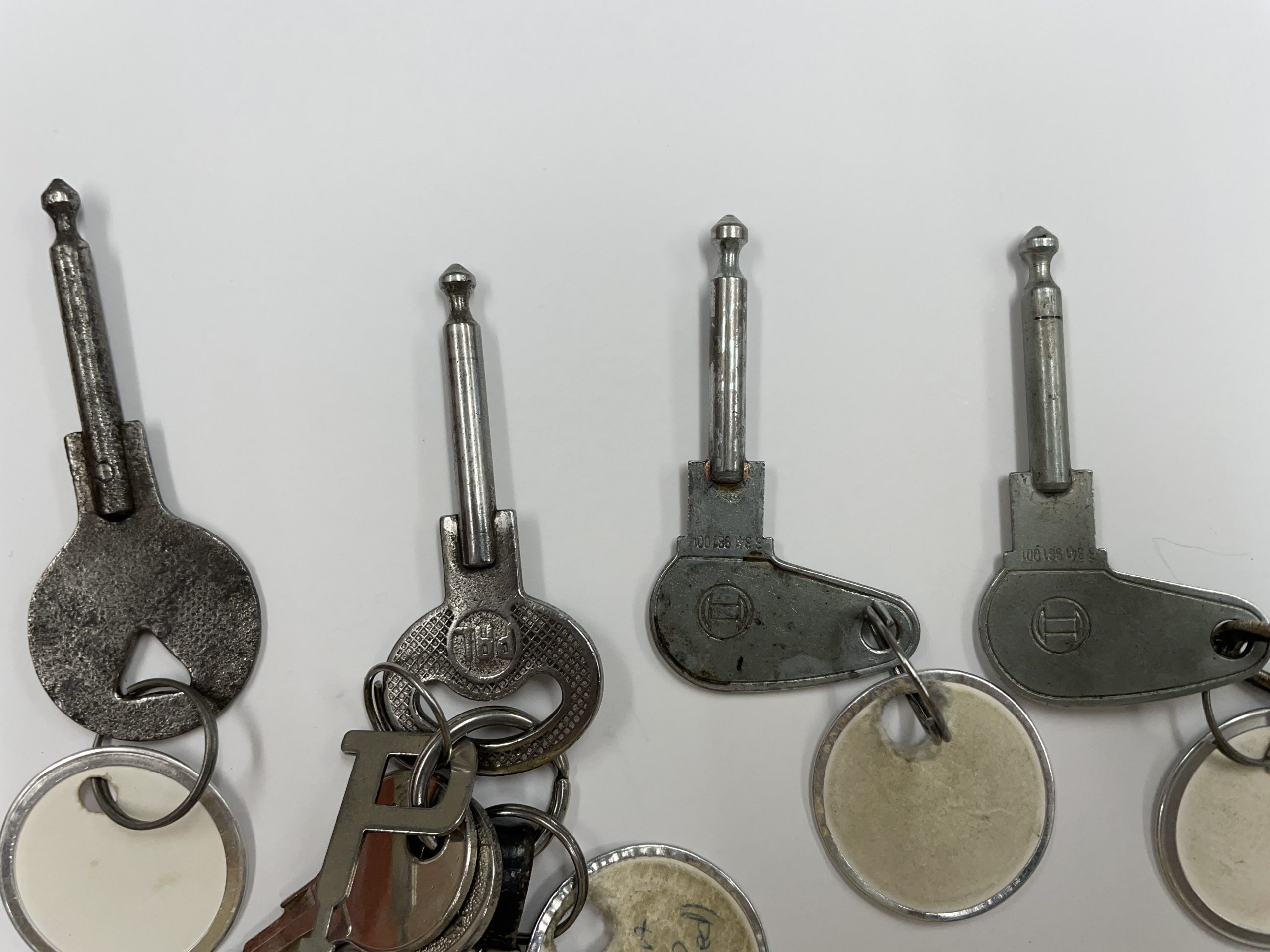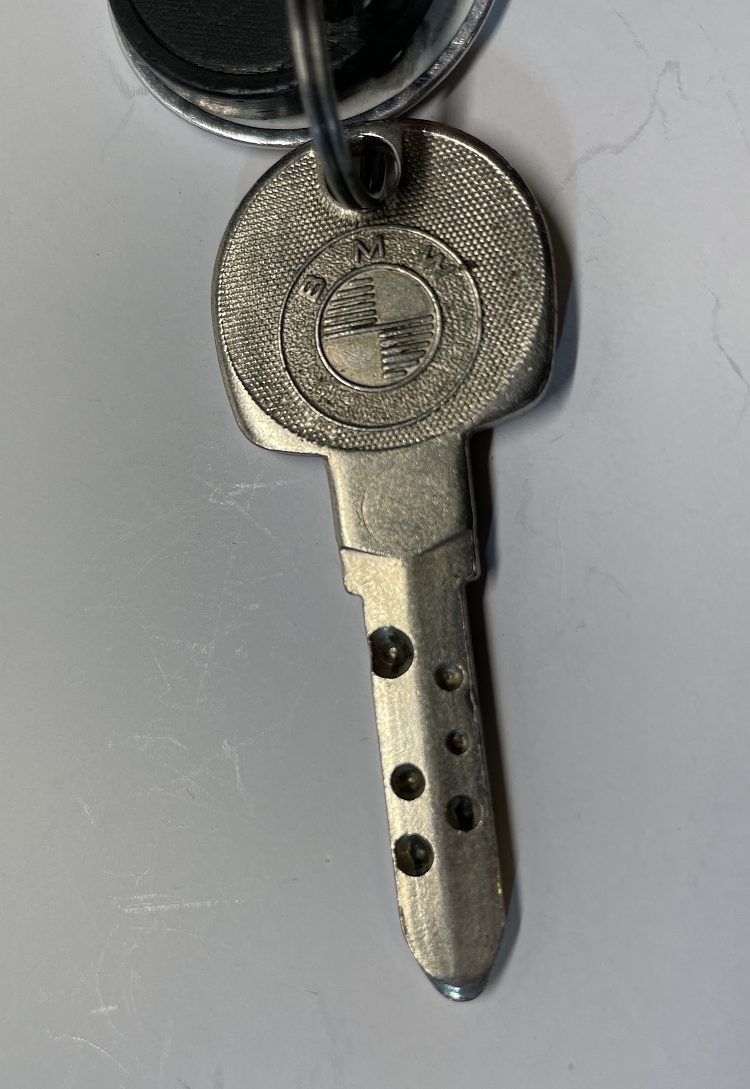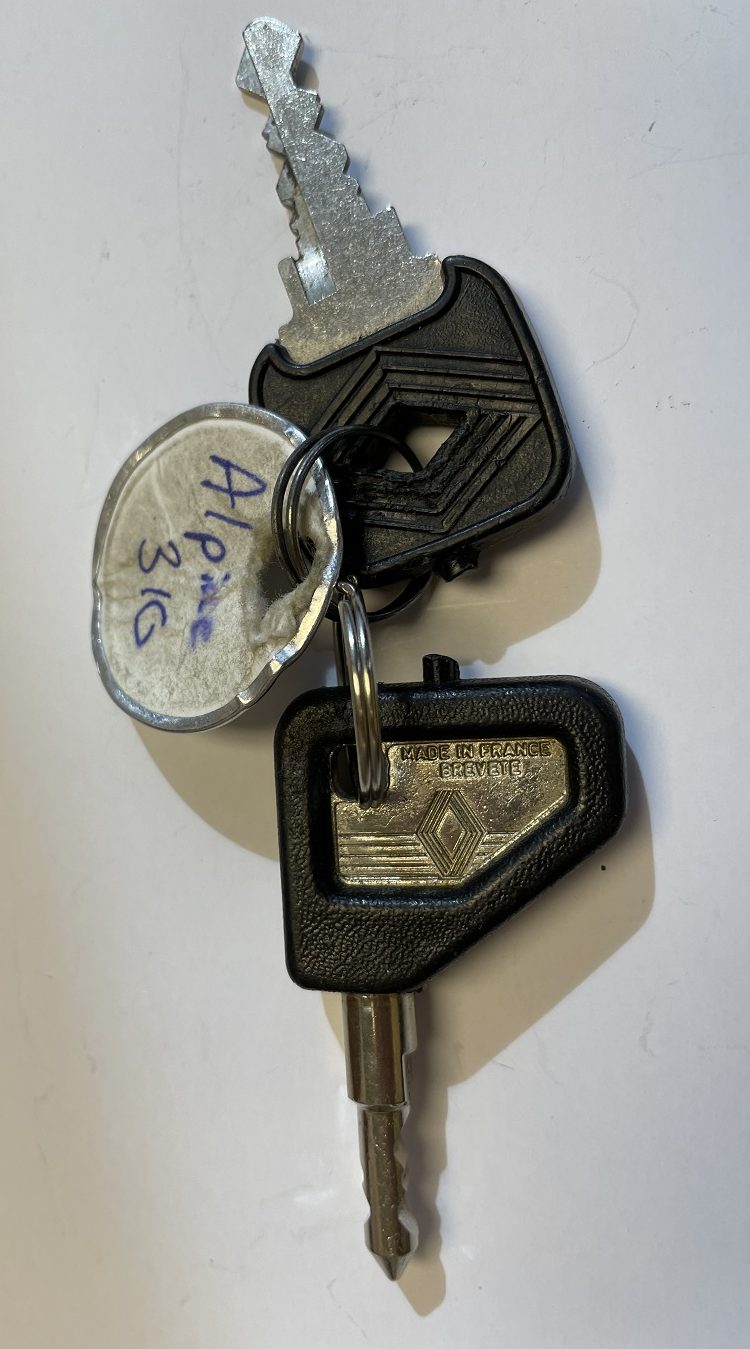Now, with over 550 cars in the collection, I’ve only selected ones that I find interesting looking. There are several cars that either don’t need a key to start the engine in the first place, or don’t have a working ignition lock anymore. Let’s dig through the Lane’s key cabinet, shall we?
These old-timey fellas are known as ignition nails. While they are all pretty similar in shape, the ends of the nails are tapered or shaped differently depending on make or model. The fact they are not toothed to a specific set of tumblers is a clue to how they operate: by inserting the nail into the ignition, you are simply completing the circuit. The engine could then be started, sometimes by pushing the ignition key in; in other instances, there was a separate button.
The close-up on this Hanomag 2-10 PS Kommissbrot’s key shows that is made by Bosch, who made several of our pre-war nail-style keys.
Let’s jump backwards in time a bit to show you our 1918 Ford Model T’s key. It’s sort-of toothed, and when inserted, you were able to select either power from the magneto or the battery.
Check out this 1934 Tatra T-57’s key. I assume the little holes act as teeth for the tumbler.
This Trojan bubble car key is A) dainty, and B) one of the keys that when inserted, acts as it starting lever. You put the key in the ignition, and push away from the driver to start the engine. Every time I start it, I always feel like I’m going to break the bakelite that encases the metal key. [Editor’s Note: I mean, there is a huge crack in there. – JT]
Jumping ahead to the 1970s, this holed key is from our 1973 BMW Bavaria, the only car BMW sold in North America that did NOT have an alpha-numeric model name, besides the Isetta. It also seems to have the Swiss Cheese holes-as-teeth sort of approach.
Ignore the ID19 key chain, because this folding key is actually from our 1973 Citroën SM. I do not know why the key hinges perpendicular to the plastic grip. It doesn’t fold flat in order to save space in one’s pocket, so I’ll have to do some research as to why the key is designed this way. Knowing French engineers in the 1970s, there has to be a reason.
This 1985 Renault Alpine 310’s key has an end that is similar to an old ignition nail. It’s also smaller in size compared to other European 1980s keys.
Skipping ahead in time, this 2013 Lotus Evora S key has to be one of the last thin, British metal keys to be manufactured. For decades, Jaguar issued these distinctive cylindrical keys. Does anyone know if these Jag-style keys had a name? [Editor’s Note: I do, Rex! These are called Tibbe locks, and Ford used them as well. Instead of tumblers like most locks, these use a series of discs that the notched key cylinder slides into. Here’s a nice video of how to pick these locks, in case you want to, you know, steal a Jaguar.
I meant learn how they work! Not steal. – JT]
Ok, I know I was teasing the youths earlier, but we do have more modern cars in the collection with interesting remote key fobs. This Porsche 911 50th anniversary edition’s remote is shaped like the car itself, yet has to be inserted and twisted to start the car. Of course, this being a proper 911, the ignition is located to the left of the steering column.
Our last interesting key is from our JDM 2014 Honda N-One. It’s one of the few cars in the collection that has a proximity key and a push-button start. However, if you know your late model Honda motorcycles, you’ll notice this is the same key as found on many of their two-wheeled offerings. I assume it was just easier to use an existing Honda product. If you think keys can be interesting and unique, oooh boy, do I have content for you. As many of you are taillight aficionados like Torch, I’ll be doing a show-and-tell of semaphores and odd turn signal indicators soon. [Editor’s Note: HOT DAMN – JT] I bet it was a cost save on the tumbler / key blanks to only have one key direction, so they designed the key body to make it easier to reliably insert first time in the correct direction. One day, she went to the grocery store and when she came out, she unlocked the cavernous trunk, loaded the groceries, got into the car, started it up, and drove home. It wasn’t until she got all the way back that she realized that, although it was a bright yellow LTD and worked with her own keys, it wasn’t her car! She drove it back to the store and there was the owner of the car she “stole” waiting next to her car. She was embarrassed, but everyone was glad to have their own car back. The person behind the desk asked what kind of car it was, then pointed to one of the service bays: “Like that one?” Yep, two Taurii with identical or close-enough keys had landed in the same parking lot. I think he got free tires or something out of it. Now, sharing key formats isn’t always great. That Lotus key right below the one from the A310? Like the editor’s note mentions, it was extensively used by Ford for a long time in all sorts of vehicles. The problem is, either the key’s security features sucked, or there weren’t that many variations, so you have lots of stories of keys from a car opening and starting an entirely different car. My father had a 1990 Fiesta that he traded in in 1994 for an Escort; the spare key from the Fiesta, which was supposedly lost when my father sold it but eventually reappeared, opened and started the Escort without a hint of resistance. I also remember someone who supposedly got in their car (another Fiesta MK3) in the supermarket parking lot and was about to drive off, engine idling and all, when they looked around the interior and realised it wasn’t their car, just a similar one parked in a similar spot in the wrong row of parking spots. My early Elise had a GM key, the same as my 80’s Vauxhall. It had a massive rectangular plastic end on it that I cut down in to the same triangular shape from the middle of the Lotus badge. I have some experience of the 911 key, it looks great, but it’s huge. If the intent was to create and unsightly trouser bulge then job done. Hence Morris Marina door handles cropping up on everything from Lotus to Range Rover for decades after the last Marina was ever seen on the road. (These are uncut blanks, the notches are only on on side of the shaft) https://i.ebayimg.com/images/g/~QEAAOSwzc5g7ETP/s-l500.jpg GM used the square head key for ignition only and the round for door and trunk locks. Chrysler used a Pentastar-shaped head for ignition and doors and the round for trunk only. Ford issued square and round keys but I don’t remember their division of function. AMC for that matter. It was always pretty much just a Detroit thing. If memory serves, in the 1960s and later, Briggs & Stratton of small engine fame manufactured the locksets for GM and AMC vehicles. I cannot recall if the GM and AMC key blanks were interchangeable. Also particularly fun was a GM ignition worn to the point of no longer needing a key at all, but that’s not the key’s fault. My dad’s stepside Chevy had that issue. Chevy used that ignition “lock” design for years. Decades, maybe.












